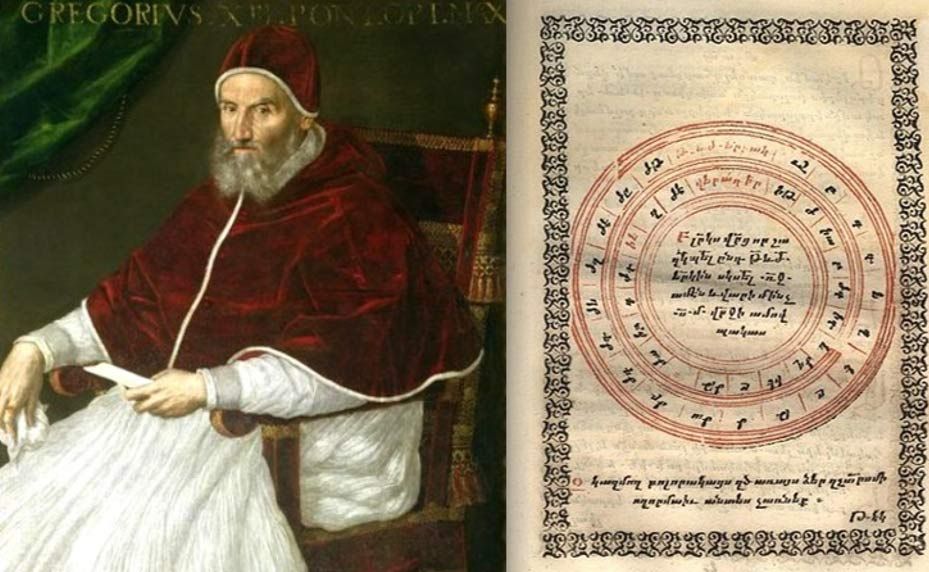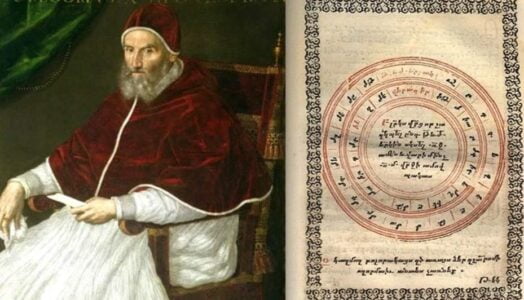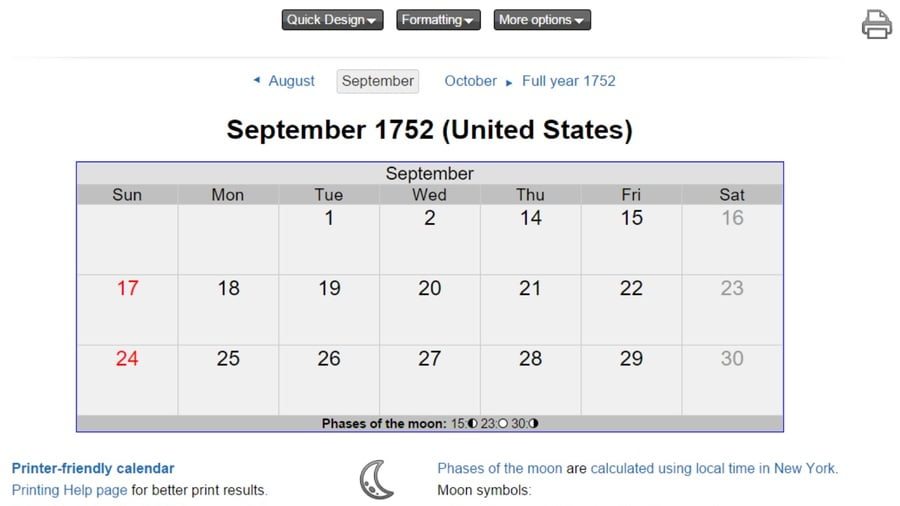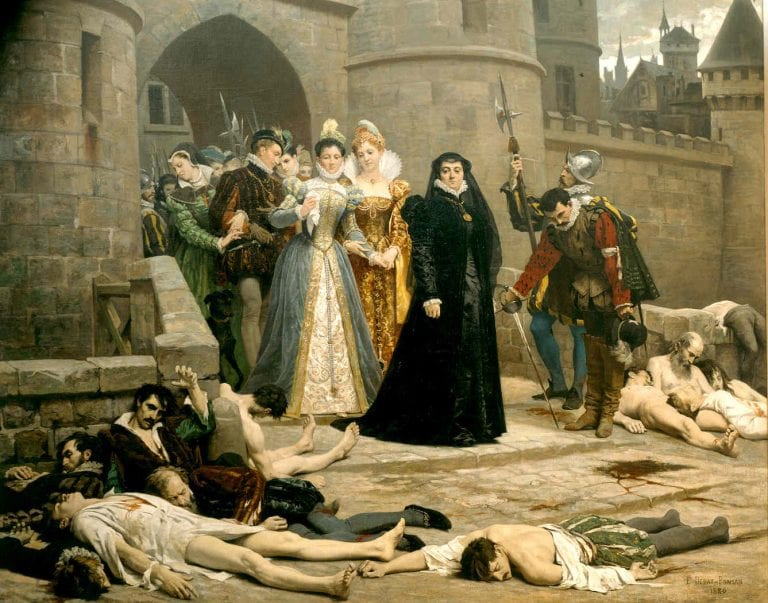On this day in history–October 15, 1582–Pope Gregory XIII implemented the Gregorian calendar. In several Catholic countries, the calendar for 1582 skipped directly from October 4 to October 15. To make up for the inaccuracies of its predecessor, the Julian calendar, a number of days had to be skipped.
The Gregorian calendar, also known as the Western or Christian calendar, is the most widely used calendar in the world today.
Its predecessor, the Julian calendar, was replaced because it did not correctly reflect the actual time it takes the Earth to circle once around the Sun, known as a tropical year. In the Julian calendar, a leap day was added every four years, which is too frequent.
Although it is not perfect either, today’s Gregorian calendar uses a much more accurate rule for calculating leap years.
Over the centuries since its introduction in 45 BCE, the Julian calendar had gradually drifted away from astronomical events like the vernal equinox and the winter solstice. To make up for this error and get the calendar back in sync with the astronomical seasons, a number of days had to be dropped when the Gregorian calendar was adopted.
In North America, for example, the month of September 1752 had only 19 days, as the day count went straight from September 2 to September 14 (see illustration).
The papal bull issued by Pope Gregory XIII in 1582 decreed that 10 days be skipped when switching to the Gregorian calendar. However, only five countries adopted the new calendar system that year—namely, Italy, Poland, Portugal, Spain, and most of France.
Since the discrepancy between the Julian calendar year and the astronomical seasons kept growing over time in the centuries that followed, more days had to be skipped in countries that switched to the Gregorian calendar in later years. Some countries, such as Russia, Greece, and Turkey, switched calendars as late as the early 20th century, so they had to omit 13 days (see table).
In total, more than three centuries passed until the Gregorian calendar had been adopted in all countries, from 1582 to 1927. The table below shows when the calendar reform occurred in some countries, including the first and the last.
Gregorian Calendar Introduction Worldwide
| Year of Switch | Country | Days Removed |
|---|---|---|
| 1582 | France (most areas), Italy, Poland, Portugal, Spain | 10 days |
| 1583 | Austria, Germany (Catholic states) | 10 days |
| 1587 | Hungary | 10 days |
| 1610 | Germany (Prussia) | 10 days |
| 1700 | Germany (Protestant areas), Switzerland (Protestant areas) | 10 days |
| 1752 | United States (most areas), Canada (most areas), United Kingdom (and colonies) | 11 days |
| 1872/1873 | Japan | 12 days |
| 1916 | Bulgaria | 13 days |
| 1918 | Estonia, Russia | 13 days |
| 1923 | Greece | 13 days |
| 1926/1927 | Turkey | 13 days |
| Note: The list only includes countries that officially used the Julian calendar before the Gregorian calendar was introduced; countries that switched from a different calendar system to the Gregorian calendar, such as Saudi Arabia in 2016, are excluded. In some cases, it shows a simplified version of events. Each country is listed by its current name, although its official name may have changed since the calendar reform. | ||
The delay in switching meant that countries followed different calendar systems for a number of years, resulting in differing leap year rules.
In the Gregorian calendar, most years that are evenly divisible by 100 are common years, but they are leap years in the Julian calendar. This meant that the years 1700, 1800, and 1900 were leap years in countries still using the Julian calendar at the time (e.g., Greece), while in countries that had adopted the Gregorian calendar (e.g., Germany), these years were common years.
Sweden and Finland even had a “double” leap year in 1712. Two days were added to February, creating February 30, 1712 after the leap day in 1700 had erroneously been dropped, and the calendar was not synchronized with either the Julian or the Gregorian system. By adding an extra leap day in 1712, they were back on the Julian calendar. Both countries introduced the Gregorian calendar in 1753.
In some non-western countries, the calendar reform took on many different guises to accommodate differing cultural and historical contexts. For example, Japan replaced its lunisolar calendar with the Gregorian calendar in January 1873 but decided to use the numbered months it had originally used rather than the European names.
The Republic of China (1912-1949) initially adopted the Gregorian calendar in January 1912, but it wasn’t actually used a due to warlords using different calendars. However, the Nationalist Government (1928-1949) formally decreed the adoption of the Gregorian calendar in China in January 1929.
Currently, the Julian calendar is 13 days behind the Gregorian calendar. This gap will change in the year 2100 when the discrepancy will increase to 14 days.
“Did you know that the Gregorian calendar repeats its program precisely every 28 years? In any 28 year slice, there will always be exactly seven leap days/years. That means there are large 28 year Gregorian recordings that are playing beneath the surface of events. A significant determining point will be a good place to begin to look at these 28 year cycles and see how they are programming us. What is a significant determining point? How about the atomic bomb in 1945? Didn’t that change everything? It most certainly did. Or how about the 9-11 in 2001? So let’s count in 28 year cycles after 1945 and see what happens. First 28 years, 1973 – now here’s something: April 4, 1973, the Twin Towers of the World Trade Center in New York City were dedicated. 28 years later? 2001. 9-11. No more Twin Towers. Twin events like Hiroshima and Nagasaki, two 28 year cycles earlier. How about 28 years before 1945? 1917. America enters World War I. 1945, America ends World War II. Are we, after the 9-11, starting World War III? 28 years before 1917, 1889. Hmm. The Eiffel Tower, world’s tallest structure in its time, three 28 year cycles before the Twin Towers. Do you see how the calendar repeats its programs? Do you really want another 28 years of this program?” – Jose Arguelles, “Stopping Time”
Gregory’s Dilemma & The Phantom Time Hypothesis
If our calendar were correct, Pope Gregory XIII could not have corrected the Julian calendar by deleting ten days when he introduced the Gregorian calendar in AD 1582. He would have had to omit 13 days. The vernal equinox (short VEQ; see Abbreviations) moves back one day every 128 years in the Julian calendar. The backwards shift would have been 13 days in 1626 years (45BC-AD1582), while the deleted ten calendar days correspond to only 1280 elapsed years.
This is a solid astronomical argument to underline the possibility of the insertion of centuries. Calendar researchers resisted this argument by experimenting with contradictory explanations of the beginning period of the Julian Calendar. Their most accepted view is that the VEQ-day was placed on 25 March in 45BC. Furthermore, it is a widespread view today that the insertion of the leap years occurred at the beginning erroneously, as we show later.
A related note. For a long time, many calendar scholars assumed that Pope Gregory XIII had to omit 10 days instead of 13 when he introduced his calendar reform because the I. Council of Nicaea (AD325) had already omitted 3 days from the Julian calendar. The omission of 3 days by the First Council of Nicaea is now rejected by most scholars because there is no evidence. There are no sources or clues about omitted days or changes in leap years after the 1st Council of Nicaea.
Enter the enigmatic world of the Phantom Time Hypothesis (PTH), a puzzling historical riddle that contends that a remarkable span of 297 years, stretching from 614 to 911 AD, never actually existed in Europe’s history books. Imagine, if you will, the notion that some of the most renowned events and figures from the Carolingian era, including the legendary Charlemagne, could potentially be nothing more than figments of imagination.
The origin of this perplexing theory can be traced back to the year 1991 when a German author named Heribert Illig first dared to present the idea to the world. Illig boldly asserted that a shadowy conspiracy had meticulously tampered with historical records, conjuring an entire epoch, the Carolingian period, seemingly out of thin air. His argument? A tapestry of dating inconsistencies, puzzling gaps within the historical fabric, and the assertion that some documents were clever forgeries—all woven together to create this illusion.
The Evidence for the Phantom Time Hypothesis
Illig’s audacious assertion hinges on an intriguing twist—a tantalizing misalignment between recorded astronomical observations and their alleged dates. Imagine, a solar eclipse supposedly witnessed in the year 878 AD, is, according to Illig, in fact, an event from the distant past, dating back to 581 AD. It’s a mind-boggling conundrum that could rewrite the very calendar of history. Moreover, Illig points an accusatory finger at those perplexing voids in historical records, like missing pages in a grand, ancient tome. One such void—where are the contemporary accounts of Charlemagne’s life?
Illig doesn’t stop there; he alleges that within the annals of history lurk cunning forgeries. For instance, the Donation of Constantine, a document bestowing temporal power upon the Pope over the Western Roman Empire, stands accused. According to Illig, this very scroll is nothing but a clever ruse, a stroke of counterfeit craftsmanship.
The Arguments Against the Phantom Time Hypothesis
As with any enigma, there are those who question Illig’s audacious claims. Skeptical historians present a compelling counter-narrative. They argue that Illig’s celestial interpretations, while captivating, fail to muster consensus among experts—a celestial puzzle with multiple solutions. Imagine stargazers gazing at the same sky, each seeing a different constellation.
Historians steadfastly uphold the existence of contemporary chronicles chronicling Charlemagne’s escapades, dispelling Illig’s theory of a historical void. The elusive “missing pages” turn out to be more like a hidden library—difficult to find, perhaps, but brimming with accounts of the time.
And the forgery accusation? Well, while the Donation of Constantine may have indeed succumbed to the relentless scrutiny of historians (now a proven forgery), the theory suggests that its downfall shouldn’t cast a shadow over the entire Carolingian era, as a single fallen leaf shouldn’t be mistaken for a barren tree.
In the eyes of historians, Illig’s audacious tale remains an elusive legend. Imagine the logistics of crafting a colossal deception, fabricating an intricate tapestry of 297 years without leaving a single thread of evidence. It’s a colossal challenge akin to painting a convincing portrait of a vanished civilization, and the mystery, as it turns out, has a glaring absence of motive.
Conclusion
The Phantom Time Hypothesis, a mystery within the annals of history, is akin to a spectral whisper—an idea that refuses to fade but remains in the shadows of scholarly consensus. Historians maintain their stance, steadfastly rejecting Illig’s claims. They insist there’s no compelling evidence to validate the audacious notion that an entire era was a conjured mirage. In the grand scheme of history, the PTH stands as an enigma cloaked in skepticism, a puzzle yet to be convincingly solved. One thing is certain, either medieval monks and clerics were the most prolific forgers of all time, judging by the volume of their output, or Illig is correct. For centuries they controlled access to official documents, placing them in a perfect position to alter or forge those documents, should they so desire.2
What’s more, their superiors could be counted on to overlook, or even approve, any textual inventions that benefitted the Church. Letters, church histories, lives of saints, and deeds to land were other common creations of clerical forgers. Almost all of these forgeries went undetected for centuries until the revival of historical scholarship that began during the Renaissance. As the vast scope of the deception gradually became evident, some scholars began to wonder whether there were any medieval church documents whose authenticity could be trusted. In 1675 the Jesuit scholar Daniel van Papenbroeck published his conclusion that all ancient deeds were falsifications created by eleventh-century monks. His announcement brought the wrath of the Church down upon him, and a few years later he humbly begged forgiveness for his doubt. Another seventeenth-century scholar, Jean Hardouin, became convinced that the majority of classical Greek and Roman literature, as well as all extant Greek and Roman coins, had actually been forged by medieval Benedictine monks. Hardouin declared that when he died he would leave behind a scrap of paper on which was written the reason why the monks had committed this forgery. Unfortunately, Hardouin’s mysterious scrap of paper was never found.2
Article Sources:
- https://phantomtimeastroexplore.com/tag/heribert-illig/
- https://bygonist.com/phantom-time/
- Heribert Illig, “The Phantom Time: The Secret History of the Middle Ages” (New York: Barnes & Noble Books, 1999).
- Ralph V. Turner, “The Phantom Time Hypothesis: A Critique,” Journal of Interdisciplinary History 25, no. 4 (1995): 637-662.
- David Herlihy, “Charlemagne and the Carolingian Renaissance,” in The New Cambridge Medieval History, Vol. II: c. 700-c. 900 (Cambridge: Cambridge University Press, 1995), 511-539.
- Michael Frassetto, “Phantom Time: Two Months in the Lost Years of the Dark Ages” (Fayetteville: University of Arkansas Press, 2007).
Further Reading For an in-depth exploration of the Phantom Time Hypothesis, delve into Michael Frassetto’s book “Phantom Time: Two Months in the Lost Years of the Dark Ages.”
For a broader understanding of the Carolingian era, peruse David Herlihy’s article “Charlemagne and the Carolingian Renaissance” in “The New Cambridge Medieval History, Vol. II: c. 700-c. 900.”





